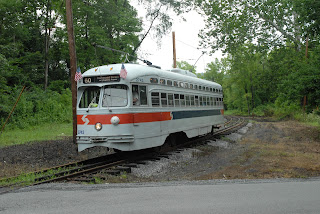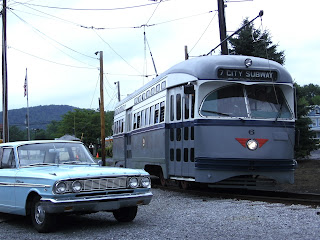Well, finally this blog is rolling almost 18 months after it was created. Guess we've been too busy working on trolleys otherwise.
Anyway, welcome to my new blog, which helps share information about the latest and upcoming news regarding Rockhill Trolley Museum's Maintenance Department. This blog replaces the former RTY Maintenance Department email list with a format that is more modern, can better support photos and images, and can be accessed via any internet link. Welcome aboard!
This past weekend was a busy and productive one for Maintenance Department and our volunteers. The following projects were accomplished:
- The Carbarn 1 pit got a thorough cleaning thanks to Bill Monaghan, Jerry Evans, and George Rich. After spending a considerable amount of time flooded recently, a think brown slime had built up on the walls. Bill power washed the walls, making it much more suitable for volunteer use. George and Jerry developed a way to run PVC conduit under the rails to enable cords to be strung without the potential for being run over, and with a little help from me, this fix was wrapped up relatively quickly.
- While Bill had the power washer running, SEPTA #2743 got a much needed bath and then Bill also power washed the front of NJT #10 to make it look a little better for the photographers at PCC Car Day this coming weeked.
- I did some inspection work on STCP #172 while Bill washed and scrubbed the pit. There had been concerns about the outbound brake valve being stiff to operate, but after a series of tests I could not get the problem to replicate itself. Thus, with Ron Gross accompanying me as a second operator (in case of emergency the museum has a two person operating rule), we made a series of braking tests using both the air brakes and the seldom used dynamic brakes. The brakes operated well in all cases, including hard emergency stops. This car remains relatively "stiff", however, probably due to the fact that it sits so often (I've heard the folks at IRM use the term "sititis"). I found the everything tends to loosen up after the car is run several times. This fall or winter the car does need some pit time so a full brake adjustment can be made, but the immediate problems are diagnosed and the car available for service.
- After finishing up the pit washing work, Bill, Jerry, and George turned their attention to the marker lights on PSCT #6. Repairs to the headlight/marker light circuit, a nagging punchlist item from last year, were completed a few weeks back when a new voltage regulator and associated fuse was installed. The project was wrapped up Saturday with the installation of new bulbs.
This photo shows the condition of the headlight wiring as found. Damage was likely due to a front-end accident when this car rear-ended #2 in Newark in 1999. This has since been replaced:

- Once I finished with the #172 and we did some car hostling, Bill, Jerry, George, and I went to work on investigating the dyanmic brake issue with SEPTA #2743. Car #2743 has been suffering from a heavy dynamic brake drag (more like a slam) for several months, and it had been several years before the low-voltage braking contactors had been cleaned (simple as it may sound, this is often the cause of dynamic brake drag on GE-equipped PCC cars). Once we opened the cabinets underneath, Jerry and I found oxidation on all of the low voltage contactors, particularly the low voltage contacts on contactors B1, B2, and B3. After about 30 minutes of work with a small file, we did a brief test run to Carbarn #2 and the car coasting perfectly. We then returned the car to the pit, replaced all the equipment covers, and made a test run to Blacklog Narrows. Again, the car operated perfectly.
Once at Blacklog Narrows, we made a test trip with #2743 into the pocket track along the side of the mountain. This was a first, as #2743 never has attempted this move before. The test was successful, although it was found that the car can only proceed to where the rear truck is nearly on the tangent before the carbody will contact the platform edge, which sticks out about 1/2" too far. Here are some photos of the test run:
Easy does it! The pole has to be tended during this operation with this car.
It's getting close. Once the skirt gets to about 1' from the MG blower grill, that's as far as you can go.
There's still plenty of room for cars to get by on the running track, and the front door clearance isn't that bad.
Verifying that #2743 can fit in the pocket track gives flexibility for this Saturday's upcoming PCC car day, especially with Altoff Siding being out of service for electric equipment at present. After these tests and a layover, #2743 was declared complete (except for a taillight bulb that will be fixed this weekend) and returned to Carbarn #1 where it will reside until PCC Car Day.
- With #2743 coasting properly, attention turned to JTC #355, which had been suffering from issues with its inbound brake valve and handbrakes at the same end which were nearly impossible to release without a pipe wrench. After securing and draining the car, Jerry and I proceeded to remove the inbound brake valve and take it to the shop workbench for futher diagnosis. Bill and George, meanwhile, did the thankless, but most important task of cleaning up tools from the day's other projects. Once disassembled, the brake valve (WABCO M-28 for the technical folks) was found to have scoring in some areas, as well as very little grease (what remained was in small clumps). It appears that foreign debris had gotten into the valve somehow and proceeded to grind itself away inside. Thus, after a trip through the parts washer, the affected surfaces were cleaned and ground smooth. It was also found that the rubber seal inside (RTY has been using for some time two part rubber seals and teflon key washers for these valves) was slightly oversize compared with other stock seals both in width and thickness. Thus, the seal was replaced and the entire assembly was lubricated with WABCO brake cylinder grease and reassembled. After reinstallation, the valve was tested and functions normally. A running test was then made to confirm the same and also to test the handbrakes.
With the brake valve repaired, attention turned to the inbound handbrake which has been a source of frustration for some time. After rehanging the chain on the brake staff itself, excessive links from the inbound end chain were removed and then the assembly reinstalled. This corrected the problem and the brakes set and release properly. The outbound end was checked as well
and found to operate fine.
Attached is a photo below of #355 in service (in Johnstown) that was recently shared with the museum from Bill Volkmer. However, look closely. The fender has been added with the aid of Photoshop. The search goes on for a shot of #355 with sloped dashes with a fender installed. Until then, #355 at RTY matches its in service days - no fenders!
- More than the electric cars got attention this past weekend. Courtney Brown, with assistance from Nevin Byers, completed the brake repairs and adjustments to locomotive M-25. Kudos to Courtney and Nevin for completing this long overdue work. Courtney made a test run in the early evening to confirm the brakes release and apply normally. This was no simple task as it involved burning out the old brake pins and installation of new ones, as well as some "thermal persuation" to free the brake beam adjustment nuts as well.
Thanks to all who made all of this work possible. Hope to see many of you at PCC Car Day and the Ragtime Piano Festival this coming Saturday!
Any omissions or errors are purely mine and purely accidental.




_(1024x552).jpg)



_(1024x705).jpg)










